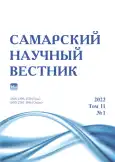Раннесредневековый погребальный комплекс курганного могильника Масленниково I в Самарском Заволжье
- Авторы: Мышкин В.Н.1, Турецкий М.А.1, Богачев А.В.2, Хохлов А.А.1
-
Учреждения:
- Самарский государственный социально-педагогический университет
- Самарское археологическое общество
- Выпуск: Том 11, № 1 (2022)
- Страницы: 213-219
- Раздел: Исторические науки
- URL: https://journals.rcsi.science/2309-4370/article/view/108345
- DOI: https://doi.org/10.55355/snv2022111209
- ID: 108345
Цитировать
Полный текст
Аннотация
Данная статья посвящена публикации материалов, полученных при исследовании погребения эпохи раннего средневековья в курганном могильнике Масленниково I. Этот некрополь находится в степной юго-западной части Самарского Заволжья. Раскопанный курган 1 был возведен в бронзовом веке в процессе совершения восьми захоронений этого времени. Погребение 2, впущенное в полу насыпи в ее южной части, относится к эпохе средневековья. Захоронение совершено в могильной яме, имеющей в плане форму вытянутого овала и ориентированной длинной осью по линии СЗ–ЮВ. Погребенный мужчина лежал вытянуто на спине головой на СЗ. У его головы лежала кость ноги лошади. В районе головы обнаружены также золотые фрагменты фольги, которые, возможно, являлись остатками символической посмертной маски, и серьги. На грудной клетке умершего погребении обнаружены остатки предмета из дерева, с серебряными обкладками у краев – вероятно, колчана. В районе таза и между бедренными костями находились остатки ножен, которые также имели обкладки из серебра. В могиле найдено семь серебряных нашивных бляшек с оттиснутым орнаментом и несколько плохо сохранившихся железных предметов. Особенности погребального обряда и сопровождающего инвентаря позволяют включить этот комплекс в число погребений, которые атрибутируются исследователями как мадьярские (протомадьярские, венгерские), и рассматривать его как захоронение индивида, интегрированного в этнокультурную среду венгров Среднего Поволжья IX–X вв.
Полный текст
Открыть статью на сайте журналаОб авторах
Владимир Николаевич Мышкин
Самарский государственный социально-педагогический университет
Email: vnm59@bk.ru
кандидат исторических наук, ведущий научный сотрудник археологической лаборатории
Россия, СамараМихаил Александрович Турецкий
Самарский государственный социально-педагогический университет
Email: maturet@mail.ru
кандидат исторических наук, старший научный сотрудник археологической лаборатории
Россия, СамараАлексей Владимирович Богачев
Самарское археологическое общество
Email: figaro9@rambler.ru
доктор исторических наук, участник
Россия, СамараАлександр Александрович Хохлов
Самарский государственный социально-педагогический университет
Автор, ответственный за переписку.
Email: khokhlov_aa@mail.ru
доктор исторических наук, профессор кафедры биологии, экологии и методики обучения
Россия, СамараСписок литературы
- Матвеева Г.И. Итоги работ Средневолжской археологической экспедиции 1969-1974 годов // Очерки истории и культуры Поволжья. Куйбышев, 1976. С. 5-73.
- Мышкин В.Н., Кузьмина О.В. Раскопки курганных могильников Масленниково I и Карабаевка I в Самарском Поволжье // Бронзовый век. Эпоха героев (по материалам погребальных памятников Самарской области). Самара: Самарское археологическое общество, 2012. С. 296-347.
- Козин Е.В. Хворостянский район. Очерки древней истории. Самара-Тольятти, 2004. 168 с.
- Васильева И.Н. Памятники тюркских кочевников домонгольского периода в Самарском Заволжье // История Самарского Поволжья с древнейших времен до наших дней. Ранний железный век и средневековье. М.: Наука, 2000. С. 268-273.
- Богачев А.В. Поздние кочевники Самарского Поволжья // Средневековье. Великое переселение народов (по материалам археологических памятников Самарской области). Самара, 2013. С. 56-59.
- Алексеев В.П., Дебец Г.Ф. Краниометрия. Методика антропологических исследований. М.: Наука, 1964. 127 с.
- Дебец Г.Ф. Опыт определения веса живых людей по размерам длинных костей // Труды VII междунар. конгресса антропологических и этнографических наук. Т. 2. М.: Наука, 1964. С. 243-250.
- Алексеев В.П. Остеометрия. М.: Наука, 1966. 251 с.
- Сташенков Д.А. Древние венгры и их окружение в Самарском Поволжье. Самара: СОИКМ им. П.В. Алабина, 2020. 120 с.
- Халикова Е.А. Больше-Тиганский могильник // Советская археология. 1976. № 2. С. 158-178.
- Иванов В.А. Древние угро-мадьяры в Восточной Европе. Уфа: Гилем, 1999. 123 с.
- Халикова Е.А., Халиков А.Х. Ранние венгры на Каме и Урале (Больше-Тиганский могильник) // Археология евразийских степей. Вып. 25. Казань: Изд-во «Фǝн», 2018. С. 7-142.
- Комар А.В. История и археология древних мадьяр в эпоху миграции. Будапешт, 2018. 424 с.
- Багаутдинов Р.С., Богачев А.В., Зубов С.Э. Средневековые комплексы могильника Просвет I // Вопросы археологии Поволжья. Вып. 4. Самара: Изд-во «Научно-технический центр», 2006. С. 400-410.
- Ковалевская В.Б. Компьютерная обработка массового археологического материала из раннесредневековых памятников Евразии. М.: ИА РАН, 2000. 361 с.
- Мажитов Н.А. Южный Урал в VII-XIV вв. М.: Наука, 1977. 240 с.
- Петренко А.Г. Следы ритуальных животных в могильниках древнего и средневекового населения Среднего Поволжья и Предуралья. Казань: РИЦ «Школа», 2000. С. 55-59.
- Круглов Е.В. Выбор в пользу угро-мадьяр: Тамар-Уткуль (курган № 3) и Яман // Из истории культуры народов Северного Кавказа: Северный Кавказ и кочевой мир степей Евразии. Вып. 11. Армавир-Ставрополь: Печатный Двор, 2019. С. 203-218.
- Бокий Н.М., Плетнева С.А. Захоронение семьи воина-кочевника X в. в бассейне Ингула // Советская археология. 1988. № 2. С. 99-115.
- Комар А.В. Древние мадьяры Этелькеза: перспективы исследований // II международный Мадьярский симпозиум: сб. науч. тр. Челябинск: Рифей, 2013. С. 182-231.
Дополнительные файлы











